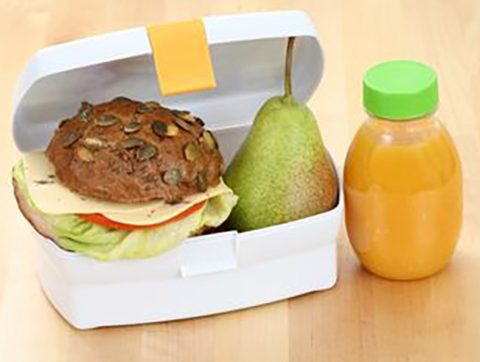Ten Tips for Enjoying & Preparing a Safer Packed Lunch

As Americans settle into their new fall routines with sending kids back to school and returning to work after relaxing vacations, they are packing more lunches for both school and work in an effort to save money. In this economy, packing your lunch or your child’s can save your family money, and ensure a safe and healthy meal.
The Food Safety and Inspection Service of the United States Department of Agriculture (USDA) released a report on the importance of food safety for “packed” lunches brought from home. Here are some suggested tips to follow while packing your lunch for school or work:
Tip #1: Keep Everything Clean
- Washing hands is one of the most common ways to stop bacteria from spreading. Before lunches are prepared or eaten, the first step to good food safety is to wash your hands with soap and warm water for 20 seconds. To help track your 20 seconds, some suggest singing the “Alphabet song/ABC’s” or sing two rounds of the “Happy Birthday” song.
- It is important to wash cutting boards, dishes, utensils, and countertops with hot, soapy water after preparing each food item.
Tip #2: Begin with Safe Food
- Perishable foods like prepackaged lunch combinations that include luncheon meats with crackers, cheese and condiments should be kept cold by using freezer gel packs or a frozen juice carton.
- Insulated, soft-sided lunch boxes or bags are best for keeping food cold, but metal or plastic lunch boxes and paper bags can also be used. If using paper lunch bags, create layers by double bagging to help insulate the food.
Tip #3: Pack Light
- Pack only the amount of perishable food that will be eaten at lunch. With no extra food to carry home, you will avoid the inconvenience of keeping leftovers at the correct temperature on the commute home.
- Be sure to prepare the food the night before and store it in the refrigerator. Then pack the lunch in the morning to help to keep the food cold longer.
Tip #4: Avoid Cross-Contamination
- Cross-contamination often occurs after reusing packaging materials such as paper or plastic bags, food wraps and aluminum foil.
- To avoid foodborne illness, discard of all used food packaging and paper bags at lunchtime. It is important to throw away perishable leftovers, unless they can be safely chilled immediately after lunch and upon returning home.
Tip #5: Keep Hot Foods Hot
- Plan to use an insulated container for foods like chili, soups and stew. One important step is to take is to fill the container with boiling water, let it stand for a few minutes, empty, and then add hot food. You will want to keep the container closed until lunchtime to help minimize bacterial contamination and growth.
Tip #6: Keep Cold Foods Cold
- Harmful bacteria can multiply rapidly if the temperatures are between 40 and 140 °F. Be sure to transport food with an ice source and refrigerate upon destination.
Tip #7: Separate Beverages and Foods
- Pack all beverages and perishable foods in separate containers/coolers.
Tip #8: Rinse Food
- Rinse all fresh fruits and vegetables under running water before eating or packing them in a lunch container.
Tip #9: Store Food Properly
- When storing your leftover food in the refrigerator it is important to use smaller containers for hot food. A storage container two inches deep or less is ideal for chilling food quickly. Larger containers are acceptable for storing cold items.
- Be sure to store food for only 3-4 days in the refrigerator.
- Label all of your storage containers with the exact date you packed the container, so you know when it is time to either eat or dispose of your leftover items.
Tip #10: Microwave Cooking/Reheating
- When using the microwave oven to reheat lunches, cover food to hold in moisture and promote safe, even heating. Reheat leftovers to at least 165 °F, ensuring that they are steaming hot. Cook frozen convenience meals according to package instructions.
Following these simple steps will help you and your to family enjoy a “packed” lunch at school and work, while keeping the food that you eat safe.
For more information about preventing foodborne illness, visit the Partnership for Food Safety Education web site at www.fightbac.org.
IFTNEXT

Episode 29: All About Food Safety Culture
In this podcast, we discuss food safety culture, including how food safety culture is established, measured, and how they are expected to change in light of ongoing advancements in food science and policy. Our guests include Hugo Gutierrez, Global Food Safety and Quality Officer for Kerry, and Bob Gravani, Professor Emeritus of Food Science and Director Emeritus of the National Good Agricultural Practices (GAPs) Program at Cornell University.
Episode 20: Trends and Consumer Behaviors in the time of COVID-19: Food Service
The COVID-19 pandemic continues to pull the global food system into new and uncertain territory. Much of this uncertainty stems from rapid shifts in consumer behaviors as a result of our collective 'new normal'.
